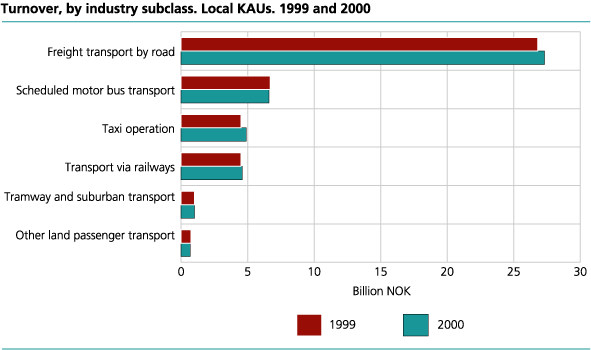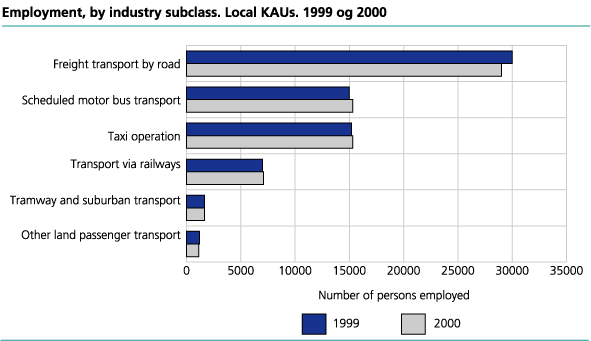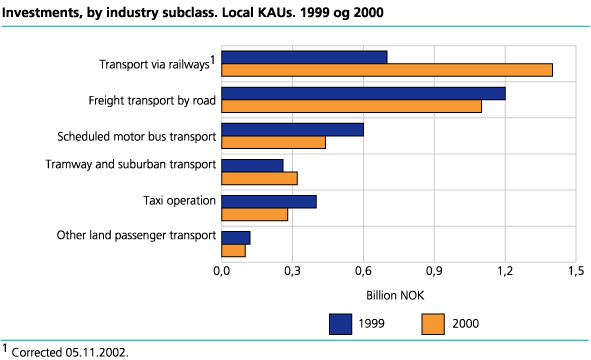Content
Published:
This is an archived release.
Increase in turnover, fewer employees
2000 was a year of consolidation for the local KAUs within the land transport industry division. Turnover increased by 0.8 billion NOK compared with 1999, while employment decreased by 535 persons. Value added rose with 3 per cent in the same period.
Turnover increased by two per cent to 45 billion NOK for the local kind-of-activity units (local KAUs) in the land transport industry division in 2000. Employment decreased by two per cent to 69 486 persons, while personnel costs increased by two per cent to 14.4 billion NOK.
Growth in taxi operation
Turnover in the industry subclass taxi operation increased by 9 per cent - to 4.9 billion NOK - due to an increase in rates at the turn of the year. Turnover in the industry subclass transport via railways increased by 3 per cent - to 4.6 billion NOK - in the same period, while turnover in freight transport by road increased by 2 per cent to 27.3 billion NOK.
Reduced employment in freight transport by road
Even though employment decreased by 3 per cent, the 29 016 persons working in freight transport by road still outnumber employees in the other industry subclasses. The local KAUs connected to scheduled motorbus transport employed 15 314 persons, while the local KAUs connected to taxi operation employed 15 307 persons in 2000.
Restructuring in bus transport
The registered turnover in the industry subclasses scheduled motorbus transport and other land passenger transport (mainly non-scheduled motor bus transport) decreased by 2 and 7 per cent, respectively. A large portion of this decrease is due to extensive restructuring in these businesses, and the figures should therefore not be interpreted as a symptom of recession. In non-scheduled motorbus transport, especially, a large number of local KAUs experienced a handsome increase in activities in 2000.
Increased railway investments
Total investments in land transport increased by 13.11 per cent compared with 1999, to 3.71 billion NOK. The whole of this increase came in the industry subclasses transport via railways and tramway and suburban transport. All the other industry subclasses experienced a decrease in investments compared with 1999.
Increase in value added
Value added at factor cost increased by 3 per cent compared with 1999.
Growth in Akershus
Turnover in land transport increased considerably in the county of Akershus, on the expense of the surrounding counties. Further south, the counties of Vestfold and Aust-Agder experienced growth compared with 1999, while Buskerud, Telemark and Vest-Agder experienced a small decline in turnover.
... and in the north
The western counties of Rogaland and Hordaland experienced growth in land transport activities in 2000, while the remaining counties along the coast up to Nord-Trøndelag experienced various degrees of decline. In the northernmost parts of Norway, both Finnmark and Svalbard experienced considerable growth in turnover connected to land transport.
Statistics on the enterprise level
The structural business statistics for land transport are compiled both on the local KAU level and on the enterprise level. On the enterprise level turnover increased by 5 per cent to 45.1 billion NOK for the land transport industry division as a whole, while employment increased [corrected 1.7. at 12.10] by 57 persons compared with 1999.
Figures on the enterprise level will usually deviate somewhat from figures compiled on the local KAU level. This is due to the fact that enterprises are registered in the industry subclass that comprises the main part of the activity of the enterprise, and therefore may be registered in a different industry than some of the local KAUs within the enterprise (see section 3 and 4 of "About the statistics").
| 1 | The figures are corrected 5 November 2002 p.m. |
Tables:
- Table 1 Land transport. Principal figures, by industry subclass. Local kind-of-activity units. 1999 and 2000
- Table 2 Land transport. Principal figures, by industry subclass and number of persons employed. Local kind-of-activity units. 2000
- Table 3 Land transport (NACE 60 ). Principal figures, by county. Local kind-of-activity units. 1999 and 2000
- Table 4 Land transport. Principal figures, by industry subclass. Enterprises. 1999 and 2000
- Table 5 Land transport. Principal figures, by industry subclass and number of persons employed. Enterprises. 2000
The statistics is now published as Business statistics.
Contact
-
Statistics Norway's Information Centre
E-mail: informasjon@ssb.no
tel.: (+47) 21 09 46 42



